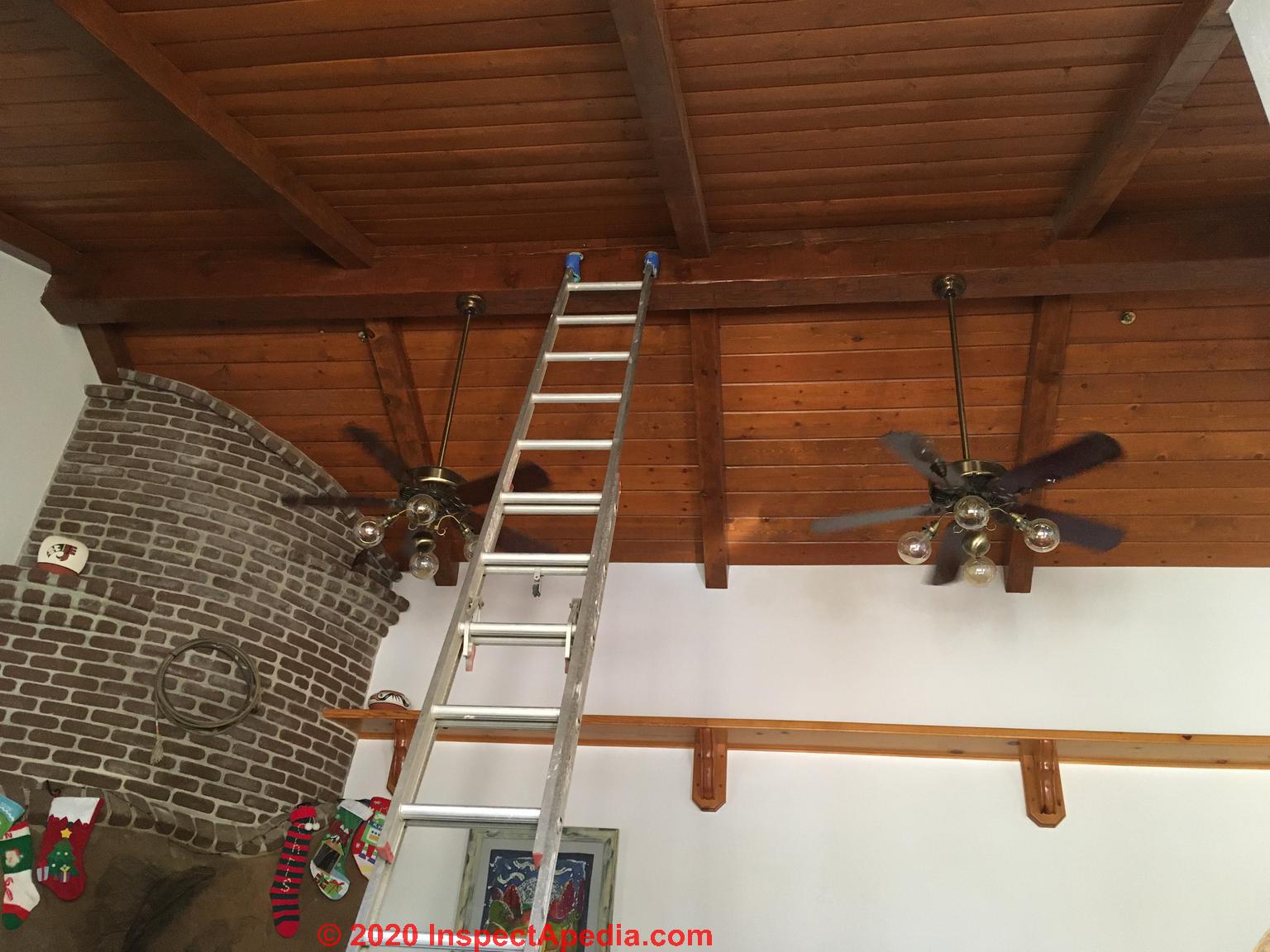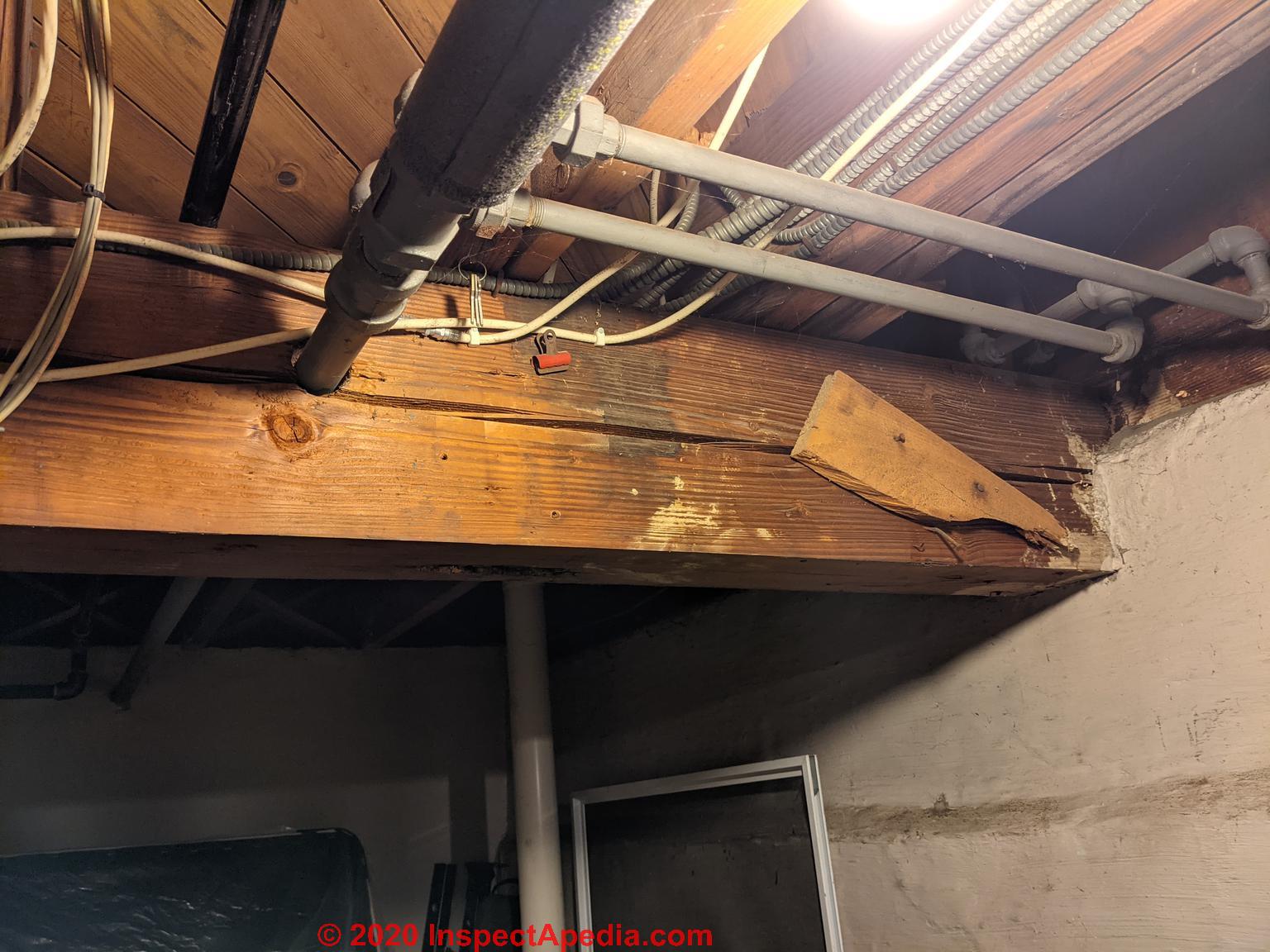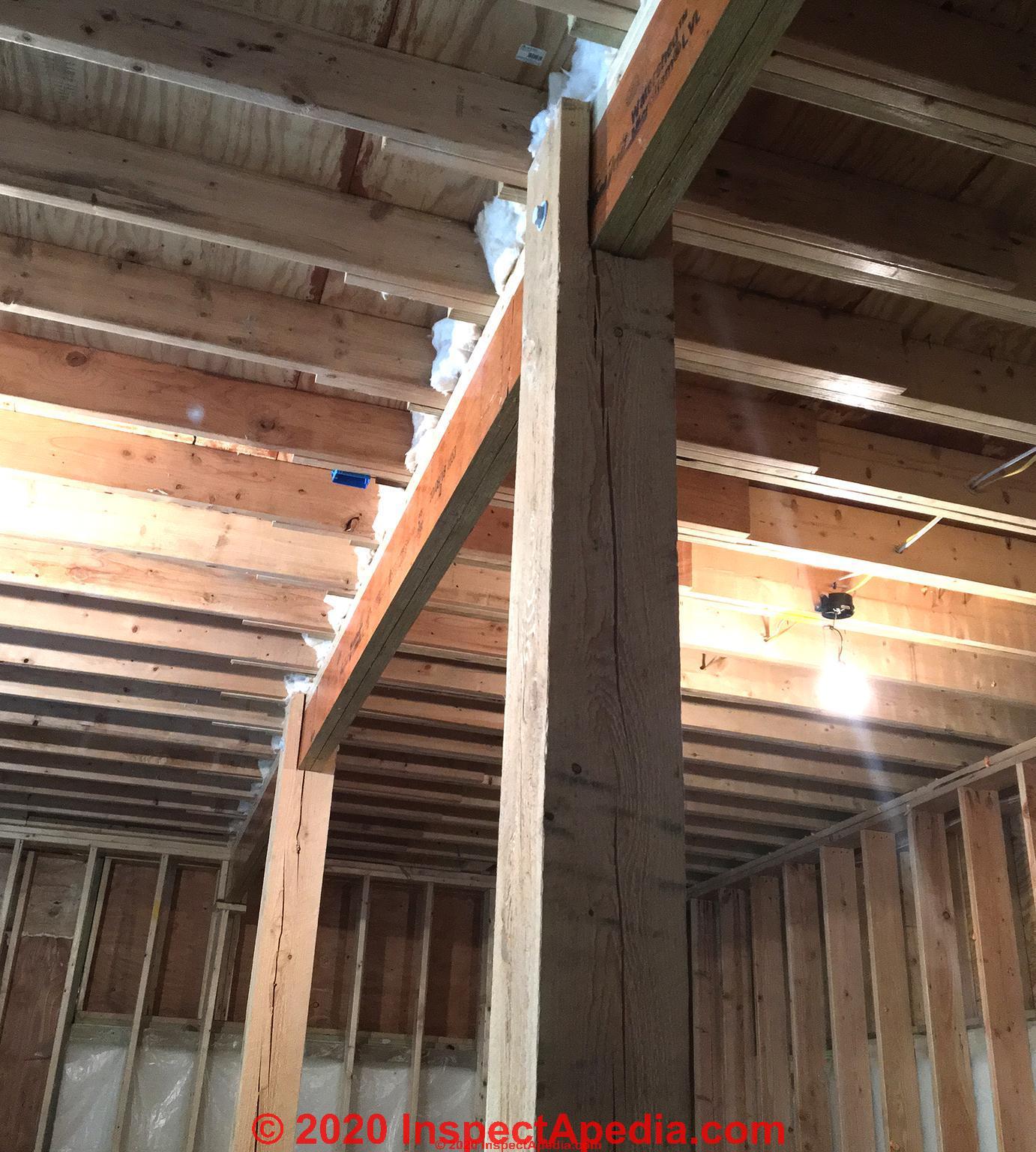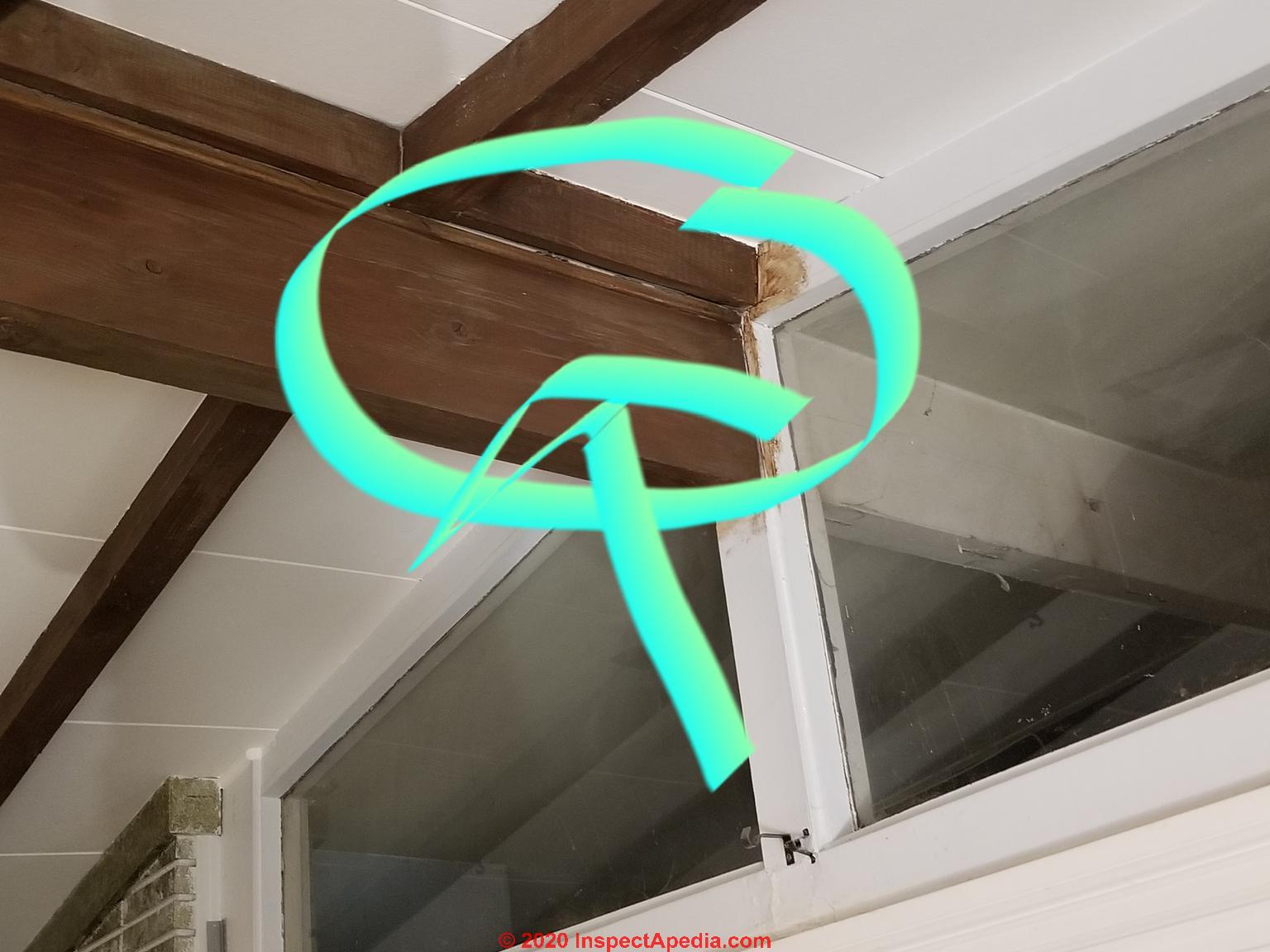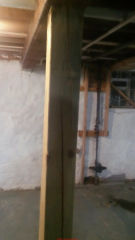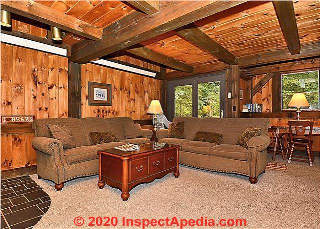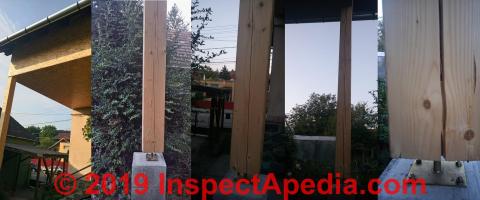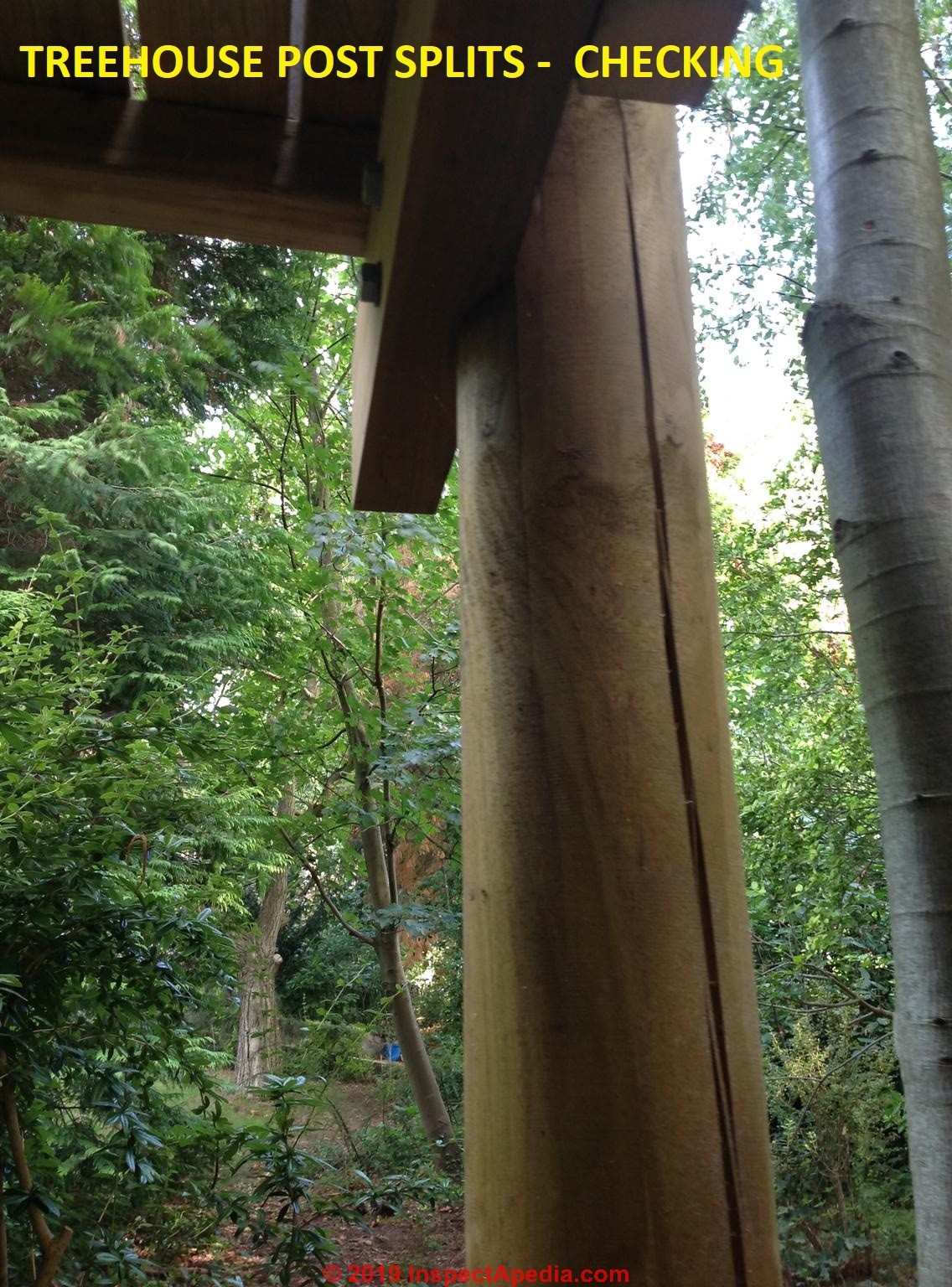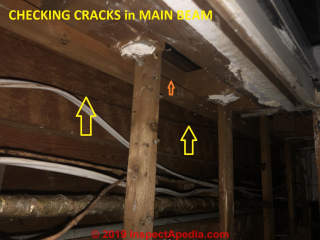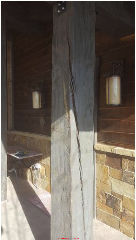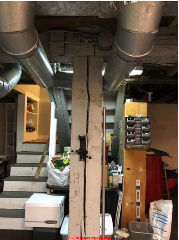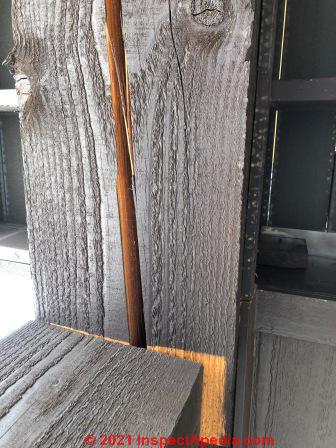 Cracks & Splits in Beams, Logs, Vigas, Posts - FAQs-3
Cracks & Splits in Beams, Logs, Vigas, Posts - FAQs-3
Checking Splits in Wood Beams, Logs, Posts
Damage Evaluation Questions & Answers #3
- POST a QUESTION or COMMENT about splits or cracks in wood beams or in log home log walls
Questions & answers about how to evaluate cracks or splits in wood posts, beams, or logs such as in a log home.
This article series defines, illustrates, and explains the cause and significance of splits or "checking" in wooden posts, wood beams, or in logs and beams used in log home structures.
InspectAPedia tolerates no conflicts of interest. We have no relationship with advertisers, products, or services discussed at this website.
- Daniel Friedman, Publisher/Editor/Author - See WHO ARE WE?
Q&A on How to Evaluate Splits & Cracks in Wooden Beams, Posts, or Logs
 These questions and answers about handling splits in log or hewn or sawn wood beams, posts, or vigas were posted originally
These questions and answers about handling splits in log or hewn or sawn wood beams, posts, or vigas were posted originally
at CRACKS & CHECKS IN BEAMS, POSTS & LOGS - be sure to review that article.
Log or beam checking is not normally a structural concern, though we might make an exception of there is significant splitting or checking exactly where a key structural connector such as a lag bolt or through bolt is located.
While extreme loading can cause a wood beam (or more rarely a post) to split and would indicate a sign of impending disastrous collapse, usually the splits or cracks found in wooden posts and beams are due to shrinkage as wood dries, occur along the grain, and do not raise a structural concern.
[Click to enlarge any image]
Do the splits in these posts and beams mean my home is unsafe?
Hi. This photo [shown above with our annotations - Ed.] is from the basement of a house I am interested in buying. Will I die in a home collapse, or will these beams and supports last longer than me (pushing 60)? - On 2020-12-06 by Liz -
Reply by (mod) - Hazards & Concerns Visible in Old House Basement Photo
Liz
I am an experienced building diagnostician but unlike the great Carnough I cannot predict how you will die - though I hope you will stay safe from COVID, duck American Political craziness, value facts and science, and live a long and happy life.
The beam checking in your photo is not, itself a significant worry of collapse.
But there are collapse hazards here including improper and therefore unsafe post-to-beam connections as well as evidence of a history of water entry - no surprise in any old house - that need repair and investigation respectively.
I post here an annotated version of an enlargement of your photo, supplementing the enlargement of your original I provided below. An on-site expert will always find information and clues, often important ones involving safety or significant expense, that are not obvious to a typical home owner or buyer. But from the limited view, over the wall here in Mexico, and offering some pro-bono help, here is what I see, marked in various colours in your photo: [Click to enlarge any image]
1. Red: unsafe post to beam connections, improperly made (no real connection, no fasteners, makeshift,possibly also prior house jacking) and signs therefore of amateur workmanship that waves a red flag: what else did this person do to the structure? Collapse risk is low but possible.
A red vertical line suggests that at least one post may also be significantly out of plumb - not vertical, also therefore not reliable building support. Collapse risk is low but possible.
2. Green circle: signs of a history of water entry, risking rot (e.g. at post bottoms,risking sagging, settlement, building movement, as well as inviting problems from wood destroying insects or mold contamination throughout the home, at all levels
3. Green question mark: what is this metal - a heating duct or connecting to a chimney? Investigate further for function, safety.
4. Yellow circle: missing discharge tube on water heater temperature/pressure relief valve, valve appears faced wrong way (over top of heater)- signs of amateur and incompetent workmanship, unsafe, risk scalding burn or drips onto and damage to heater.
5. Orange circles structural repairs inadequate?: steel telepost added support, into soil, not permanent, risk rust damage, out of plumb?- what is this supporting? Investigate further. Also orange circles at beam may mark an unreliable or damaged floor beam connection: investigate for insect damage, rot, unreliable structural connection. Collapse risk is low but possible.
6. Purple question marks - Leaks? what are these containers, at least one appears to have water: are these catching a leak from above? Investigate further.
7. Insulation: Why is there fiberglass insulation left on the floor - none visible elsewhere? Remove (wet, mold risk) - what insulation project was undertaken where? Properly done?
8. Basement walkout exit needed? Green circle at bottom of closed-off basement walkout door (OSB- oriented strand board)- not only is there water entry at this point, but the exit door has been closed and sealed - what's on the other side of this door?
How will repair-people enter or bring in new or take out old mechanical equipment when such work is needed? Is the old walkout stairway still there, catching roof spillage and sending it into the basement?
On 2020-12-05 by Ryan - just noticed these cracks in wood - need advice
Hi, attached are pictures of our living room beam. House was built in 1987, we bought it last year.
I just really noticed these (possible checks) in the wood recently so I’d like to get some more experienced advice.
Climbing up in the ladder I see what appears to be a bit of the original stain inside some of the cracking which tells me they’ve been there a while, at least in a smaller version.
I’d just like so better feedback for my peace of mind.
Thanks for the help, Ryan
Reply by (mod) -
Ryan
Regrets but I can't make out beam cracks or checking in that photo, but you can of course compare what you see with the typical beam checking crack patterns describedt CRACKS & CHECKS IN BEAMS, POSTS & LOGS where we give general advice on how to evaluate such cracks or gaps.
Crack in my main support beam opened from 0.375 to 0.395 width over 3 years: a concern?
I have a crack in my main support beam that has opened from 0.375 to 0.395 width over 3 years, but have of that was just in the last 3 months.
Should I be concerned? The crack is about 2 inches deep on a 5 inch beam, but there is a similar crack on the opposite side that is 1 inch deep. - On 2020-12-05 by Jon W -
Reply by (mod) -
Jon
That looks like normal beam checking as described on the page above.Followup by Jon W
Thanks for your assessment. If this gets worse, at what point should I hire an engineer? If the crack opens through the full thickness? I have read in other comments it becomes more difficult to address the longer you wait. Thank you.
Reply by (mod) -
Jon W:
If you saw signs of sagging, buckling, settling of the structure, or perhaps more-subtle clues like doors and windows that stop operating properly then further investigation would certainly be in order.
More details are at
WOOD STRUCTURE ASSESSMENT - home
On 2020-10-16 by Jason B - cracks in wooden chord-bottom of wood-metal web joist (floor truss)
 Hi there. Have a metal web joist and have noticed increased checking in basement (since we purchased the home two year ago - total age 20 years now) in multiple joist members. Wanted to make sure this seems like normal wood checking and doesn't appear to be any structural issue.
Hi there. Have a metal web joist and have noticed increased checking in basement (since we purchased the home two year ago - total age 20 years now) in multiple joist members. Wanted to make sure this seems like normal wood checking and doesn't appear to be any structural issue.
No sagged on any joist has been noted, nor weak floor areas. Checking has increased since basement is kept dry (around 35-40% with dehumidifier).
Just unnerving for the layman to see checking and think "split = broken wood!".
On 2020-10-16 - by (mod) -
Jason:
That looks like normal wood checking and is not a structural concern as long as (this is just my OPINION) there are no spots at which splits or checks in the wood members of these trusses also cause loosening or separation of the actual structural connections.
Look closely at how those metal webs are connected to the wooden floor truss chords.They're basically a metal toothed plate that is pressed into the wood, pushing dozens of tiny v-shaped arrows into the wood.
If any of those truss plates has separated from the wood then repair would be appropriate at those spots.
On 2020-09-07 by Aaron W - Significant checking in a post: do we need to install a collar?
 Recently purchased home and noticed on a 10x10 post pretty significant checking, all along the grain.
Recently purchased home and noticed on a 10x10 post pretty significant checking, all along the grain.
About 5 " deep at points and 1/2" wide. Unclear if the location of the crack leading up to the beam presents a structural issue.
Would appreciate your opinion.
Additionally do you know of any place where we could get a collar made to prevent further splitting?
On 2020-09-07 - by (mod) -
Aaron,
I agree that that's significant checking in the vertical post however it's also normal and not normal and structural concern.
I would be concerned for checking in a post if the splits are at a location the compromise the actual structural connection. In your photo we really can't see how those connections were made.
That's something that you may want to look at more closely.
On 2020-08-30 by Brandon - is this beam split normal and OK?
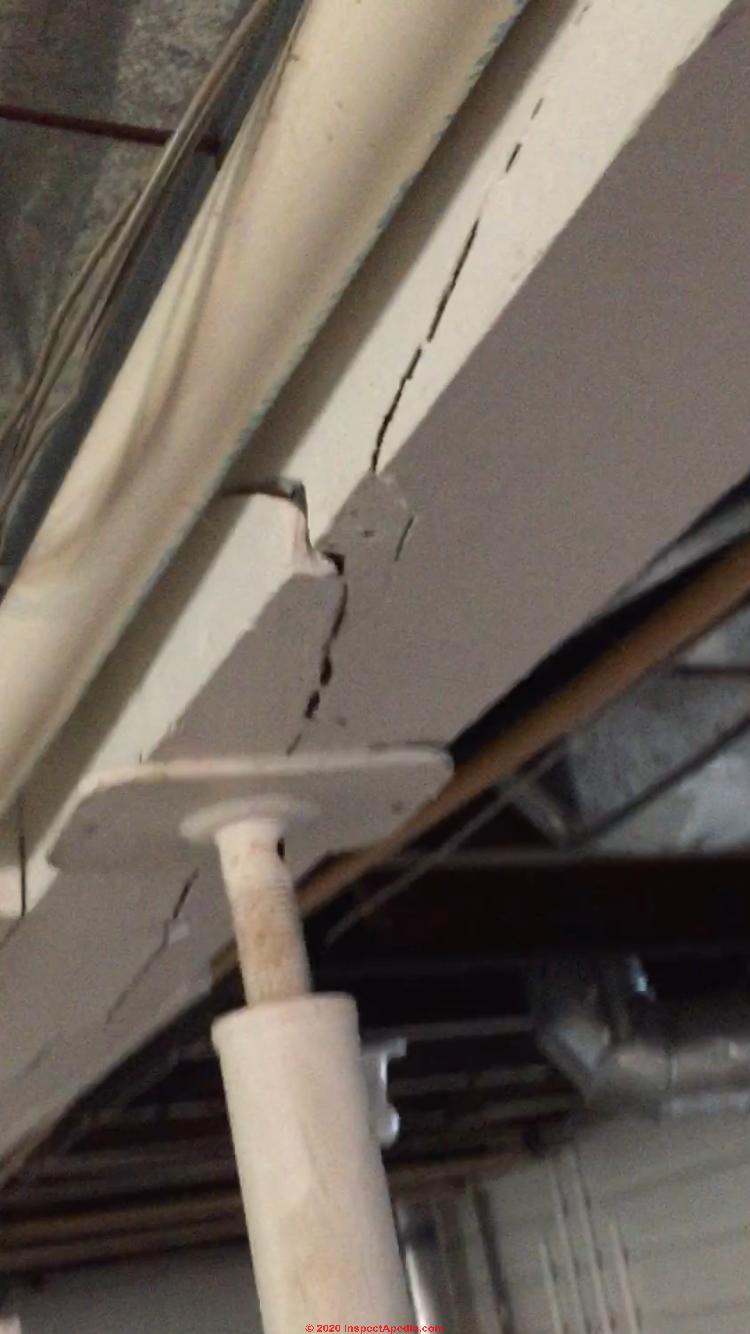 Is this a normal check or a crack?
Is this a normal check or a crack?
On 2020-08-31 (mod) - NO that is a beam failure: it is actually breaking where it cracked / split
That's a break in a supporting beam, Brandon.
Possibly there was excessive point loading above or a missing post.
That telepost is at best a temporary repair, though the post is not properly-installed and in mhy OPINION is unsafe as
I see no structural connection between post and beam (and the telepost is upside down).
I suspect that normal shrinkage cracks combined with an unfortunate location of a knot in this girder combined with loading from above conspired to cause a break and sagging.
It's more than "normal" and more than "cosmetic" damage.
On 2020-08-26 by Dan - patio pavilion post 9 feet tall is deformned at a knot - what do you think?
 Hi,
Hi,
I have a patio pavilion post that is a 6x6 and 9 ft tall that has deformed sideways due to cracking at a knot about a foot off the ground.
I built it almost exactly 2 years ago with green DF #2 after staining it, so the drying phase is about right for this to be checking
but my concern is over the lateral bow that has developed in the direction that the roof lateral load would push it in.
It's anchored to the concrete with 5/8" wedge anchor and has about a 10' span to the next post in either direction.
Should I be concerned this is NOT normal checking due to the knot?
Replacing the post is not an option as it's supporting a fourth of the load, but some sort of band or wrap may help but I'd prefer to avoid for visual aesthetic reasons
Thanks for any thoughts.
On 2020-08-31 - by (mod) - replace the post
Dan
OPINION: (I'm not a structural engineer) - I see splits along the supporting post at two big knots. It's the breaking at the knot that's the worry, not that that post isn't perfectly straight.
A post is in compression; usually normal checking splits are not a concern, but given those huge knots that could pop out,
I'd watch that post for failure, or safer, replace it.I don't agree that the post can't be replaced because it's carrying a load. We've done just such replacements many times.
The general procedure is to use jacking and a temporary post to carry the load, then remove and replace the bad post.
Watch out: If you're not familiar with that process, as making a mistake could be dangerous, get help from an experienced structural repair contractor.
On 2020-08-24 by Maria M - 'Checking' cracks in post at notched joint & thank you for this website
Glad to read that 'checking' is normal. My question concerns the checking running up to the notch that holds the LVL beam. I noticed the cracks in the 8" x 11ft hemlock posts of our new build recently, Aug 2020.
The posts were put in around Feb, 2019.
Judging by photos I've taken over time, they may have been there a few months and I just didn't pay attention. The building (a large 2.5 story art studio with a loft) is still under construction.
Total height of building to the roof ridge is 37ft(h), and the building is 32'x32'. Is it normal for posts to crack this soon? There are four main support posts in the semi-basement and all four have cracks on two opposing sides and one has it on three sides.
The two rear ones (pictured) sit in the center of the building are worse than the two front posts ie closest to the garage door (front posts are taking the weight of the loft on the main floor above).
I would like to know if you think there may be structural problems in the future (like I said we aren't yet finished the construction) given that the checking runs right up to the notch where the LVL beams sit. Bolts placed through the walls of the post and LVL make the joint connection.
I'm most concerned about the cracks, at identical spots on both sides running up to the notch. Thanks, Maria
On 2020-08-25 - by (mod) -
As the checking is nowhere near the through bolt you're probably ok, Maria.
On 2020-08-24 by Devon - we got a new roof and now see a gap in our beam: is this a worry?
We recently got a new roof added and the load was put on the edge of the house. It caused an inability to open or close our screen doors. We noticed a gap in between the beam.
The load has been removed and the doors have resumed their normal ability to open and close without hindrance.
But I cant help but be worried about the beam crack.
I know it's the main support beam for all the beams.
On 2020-08-25 - by (mod) -
Devon what happened at the house eaves under unusual roof load is likely to be independent of that ridge beam.
But honestly I can't make out your structre from that photo: I don't see the beam supports - carrying its load down to a pier or foundation, I just see a beam that seems to end at a window.
This needs further investigation, on-site.
On 2020-08-21 by Nick
 Hello guys, I am really concerned about this checking which is happened on the beam that goes to the roof and is used to support roof construction made from metal.
Hello guys, I am really concerned about this checking which is happened on the beam that goes to the roof and is used to support roof construction made from metal.
There are 2 beams going in parallel this one spread out from one another, but they have decent checking not as big as this one.
I could not see through it but it is pretty deep.
Other side is not split but this one seems to be grown in size since we moved in this house (we have been living in the house for 2 years but this wooden construction is probably around 4-5 years old).
Am I risking my roof crashing down at me?
On 2020-08-22 - by (mod) - normal post checking cracks - probably OK, check the connections.
Nick, as I opined to Tony, those are typical checking cracks;
Checking crack are not usually a structural issue - unless there is severe checking at a location that compromises the actual structural connections at bolts or lag screws.
On 2020-08-13 by Tony - Evaluate the diagonal cracks in this post
 Hi,
Hi,
Clueless homeowner looking at some diagonal cracks in our 6x6 PT deck posts.
One picture attached, the rest on: https://imgur.com/a/2Uaqrym
If these look bad, what type of contractor can we call? Do we need a structural engineer?
Appreciate any advice you can lend!
On 2020-08-14 - by (mod) -
Tony
Checking cracks in a post are not usually a structural issue - unless there is severe checking at a location that compromises the actual structural connections at bolts or lag screws,OR if you see that the post is actually breaking where the diagonal crack reaches its end, for example at the upper end of the diagonal crack in your photos.
On 2020-08-14 by Tony
great to know, thank you!
On 2020-06-12 by Sheri
 My main ceiling beam across my living room has a crack. Or two. Normal?
My main ceiling beam across my living room has a crack. Or two. Normal?
On 2020-06-13 - by (mod) -
Sheri
Thank you for the ceiling beam crack photo and question; yes, that looks to me like normal wood beam cracking as discussed on the page above.
On 2020-04-23 - by Anon - Who sells the clamps to stop logs from splitting?
2020/04/22
Anonymous asked by private email:
Hi there ,Im trying to find someone who sells the clamps to stop logs from splitting. Any suggestions ?
Moderator reply:
There are manufacturers of connectors, bolts, and possibly clamps used in log construction, but I have not seen any product claiming to stop a log from splitting.
That's because splitting,or "checking" which is the better term, occurs in logs as they dry out after being used in construction - it's generally both unavoidable and normal.
Generally a split (normal checking) is a structural concern only is if it is compromising a connector - which is uncommon.
Take a lookat CRACKS CHECKS SPLITS in BEAMS, LOGS & POSTS
where we explain checking and splitting
Also see examples of some custom-fabricated clamps retrofitted to checked roof support logs in photos by Doug Connor atWOOD BEAM LOG VIGA CRACK REPAIR METHODS
I've looked for a vendor of rounded clamps to add to badly checked logs in log homes but not found such. I think that's because of the variability in log dimensions, shape, condition, and need. So if you actually need clamps for your checking logs - say because of a failing connector run through severe checking-splits, you may do better to make some circumference measurements and a sketch and take that to a local metalworking shop.
Perhaps if you show me photos of your situation I can comment further
On 2019-11-30 by LogHome - How do I know the support post will be sufficient 20-30 years down the road?
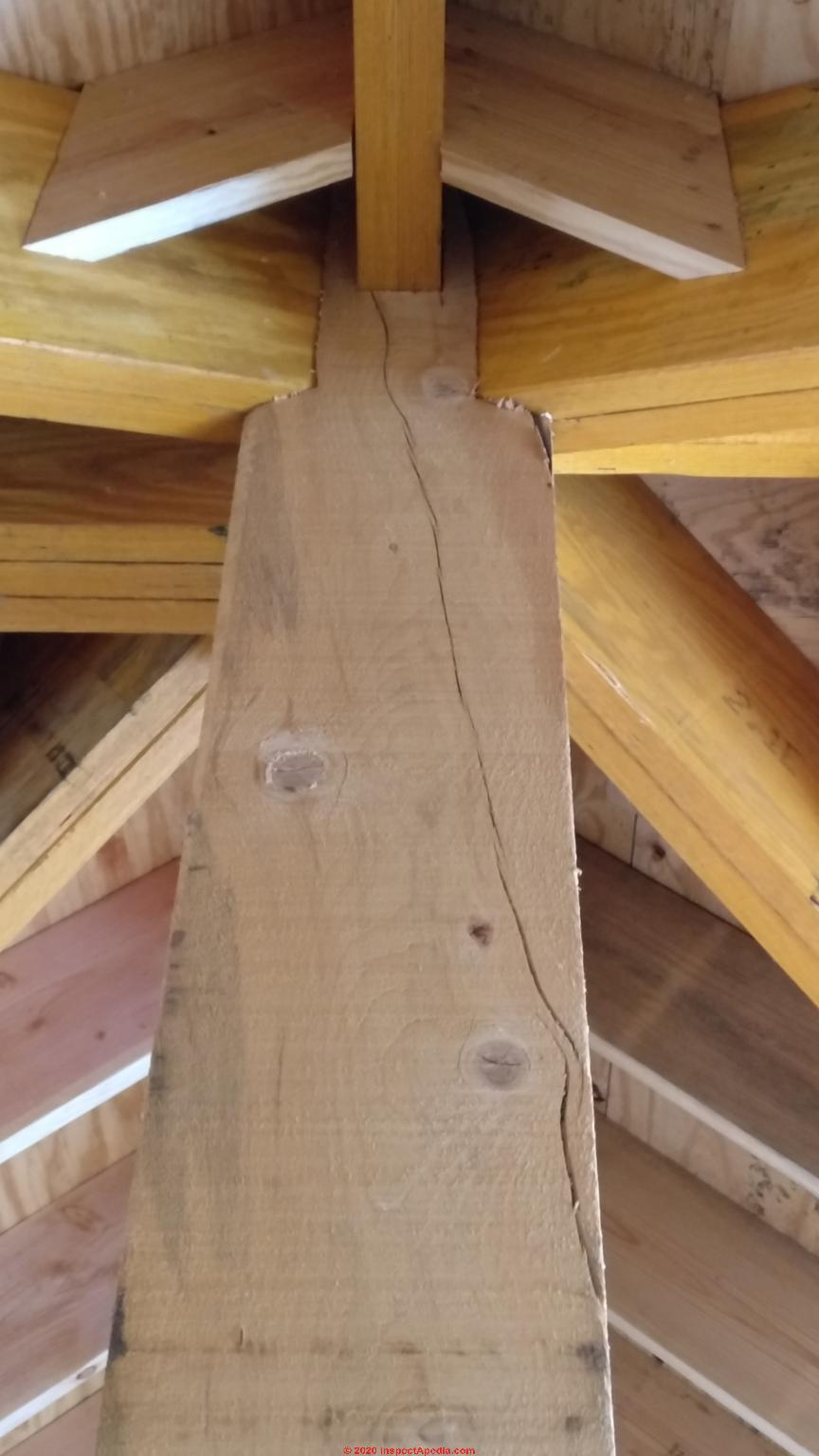 Facts - Loft has a very large vertical support post that connects six glulam ceiling beams .
Facts - Loft has a very large vertical support post that connects six glulam ceiling beams .
The post has multiple notches to connect to the glulam beams.
I do not see bolts, screws, etc.
My concern is the various splits or checks in the vertical support post may not be appropriate.
The splits are on three sides of the posts.
The ceiling glulams are the major support beams for the living room, loft, valley beams, and two bedrooms.
How do I know the support post will be sufficient 20-30 years down the road? Various pictures that denote 3 sides of the post are attached (pictures 1-6) .
On 2019-11-30 - by (mod) - checking or splits in a vertical post supporting something - significant point loading is important
Log
Thank you for an interesting question on checking or splits in a vertical post supporting something ...
1. what are the country and city where the home is located? and what is the age of the home?
2. what are the loads on this post: roof, floors, snow load? it's unclear what's being supported (as well as on what the post is bearing below);
3. what is the history of this crack: was it in the post at installation, if not when did it appear?
4. You say there are splits on 3 sides of "the posts" - so are you seeing the same pattern in the same location on other posts?
5. Are these 4x4 posts or what other dimension?
In general cracks that do NOT go fully through a post or beam are checking cracks that result from drying wood and are not a structural concern, with three common exceptions, all of which could apply to you::
1. Splits that can compromise existing structural connections are important and need investigation and perhaps repair or reinforcement (banding, sistering, through-screwing, or post replacement)
2. Point loading at a post top or bottom combined with a diagonal split at that point might under load lead to a failure
3. Your data and inspection and assessment are incomplete - having not fully examined the structure, site, history, materials, etc.An on-site structural or civil engineer experienced in residential frame construction or even an experienced home inspector is likely to see important considerations that would not have been noticed by a homeowner.
In every case in which I've gone to a site for which an owner/occupant has provided photos and data that they noticed, I've found important additional information that amend or re-focus the problem and its solution. It's not that I'm smarter than you but I may have different experience and a different eye.
Photos showing the actual shape and construction of the building and of other splits or checks and construction details might of course permit more comment.
Thank you for asking.
On 2019-11-26 by J - 4 cracked post in my basement
I have a basement with 4 cracked posts. I haven’t had issues with the house but I’m wondering if the posts need to be replaced or is it fine as-is. Pics attached.
On 2019-11-26 - by (mod) -
J
What I see in your photo is normal checking type cracks in a vertical post - not a structural concern.
However, though the photo is blurry, I cannot see any evidence of an actual structural connection between the top of the post and the beam overhead. You might want to look at post to beam and post to pier connections more closely.
On 2019-10-27 by Liz - preserving old Vigas in New Mexico Log Home
Hello. We have a log home in the mountains of New Mexico. It is a part time home so it is left empty 9 months out of the year. No central heat or air. We have load bearing beautiful exposed wood Vegas in our living room.
The builder of the home put a shiny varnish on the beams after installation 10 years ago. There is quite a bit of natural checking.
Is there something speciific that I need to do to preserve these vigas? Re varnish every few years? Clean with an oil based cleaner such as Murphys Oil Soap? Or just dust and leave alone? Please advise. Thank you
On 2019-10-27 - by (mod) -
Liz
If the vigas (beams) are all indoors, protected from weather, re-coating with a new layer of varnish is in my opinion principally a cosmetic question.A cleaner such as Murphys Oil Soap might remove accumulated dust or oils but I'd take care about using any cleaner that might be compatible with a varnish or polyurethane with which you intend to follow-up; so read the product instructions for both.
Normally you'd dust and forget, or if there were smokers in the home then both beams and walls may need cleaning and re-sealing or re-varnishing for aesthetic or odor control reasons.
On 2019-10-15 by Trisha
I read your article and found the explanations very helpful. Thanks.
Does this look like normal checking in the both the vertical and the horizontal beam?
Thanks, Trisha
On 2019-10-15 - by (mod) -
Details are a bit hard to make out but from what I can see, yes, typical checking cracks.
On 2019-07-22 by loveel
I saw cracks in the major beam of my house. Couple inclined cracks at the ends of beam. The ends of the beam looks a little bit twist. The post at the end also developed cracks.
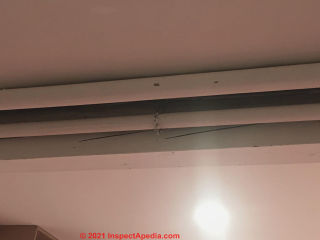
On 2019-07-22 - by (mod) -
That looks like normal being checking.
On 2019-06-19 by Annie - 3 inch openings in outdoor Vigas
I have outdoor vigas, similar to the round beams with the clamps, that are cracking. The openings are sometimes as wide as 3 inches! I'm considering sanding and then oiling/refinishing them all, but should I do anything about the large cracking?
I was thinking about maybe drilling some opposing screws into them, maybe to stop them from splitting more. Do you think that's okay?
On 2019-06-21 - by (mod) -
3 inches is unusually wide unless the log vigas are very large diameter. Can I see some photos?
Normally the issue isn't structural, as you'll read in the Continue Reading - article link given above.Where it is we add iron bands or steel structural connectors.
But an up-facing check in any log is a crack that catches water and can speed rot. You might use a PermaChink type product.
On 2019-08-29 by Agnes - this post holds up our second floor: is this cracking normal?
We are in the process of adding a 2nd floor to our home ( a mansard with lightweight roof tiles ) outer constructions finished a month ago and since then we noticed more checks appearing in the support beam ( pictured below from a few sides )
This is the sole beam holding a part of the 2nd floor so I was wondering is this normal, or is it a cause for concern and needs some immediate reinforcing? Thank you!
On 2019-08-29 by (mod) - Check the Security of Structural Post Connections when checking cracks might affect the connectors.
Agnes
Normally checking, even deep splits in posts and beams are not a structural concern; in your photo the posts are under vertical load and would not be particularly affected by these cracks.
However in my OPINION there is an exception to the "don't worry about it" rule for beam or log checking.
Your posts are supported by mounting atop a single steel pin that is in turn bolted to a concrete block pier.
Watch out: IF a post has deep checking splits or cracks that are around or quite close to the pin location in the post bottom
THEN it is possible that the post is not well-secured to the pier.
That appears to me to be the case in at least your right-most post-to-pier checking crack photo.
In that case it may be sufficient to install a suitable band or pair of bands around the post bottom - if nothing else, for peace of mind.
Certainly if you peer into one of those post checks around the bottom pin and if therein you can actually see the pin, then in my opinion the connection is inadequate.
A second question is hinted-at by your photo: the posts appear to sit atop stacked concrete block piers. We cannot see if those piers were themselves reinforced by re-bar or some other means.Depending on the pier height (or number of stacked blocks) a building code compliance inspector might have wanted internal reinforcement.
Ask your local building inspector for an opinion.
Finally, also this is just an OPINION (I am NOT a licensed structural engineer), whenever I constructed a high deck or porch, even with careful attention to the structural connections (those are absolutely critical to avoid a catastrophic collapse), I also liked to install cross bracing between outer or side post sets or both.Cross bracing adds considerable rigidity and safety to the structure.
(Aug 30, 2019) Agnes said:
Thank you very much for the detailed explanation and advice. I really appreciate it. We will definitely ask an engineer to reinforce that beam for safety measures and peace of mind. Thank you again and have a lovely day!
(Aug 30, 2019) (mod) said:
Glad to assist Agnes; do keep me posted on what your engineer says and show us photos of the repairs that are made.
On 2019-08-22 by Kylie
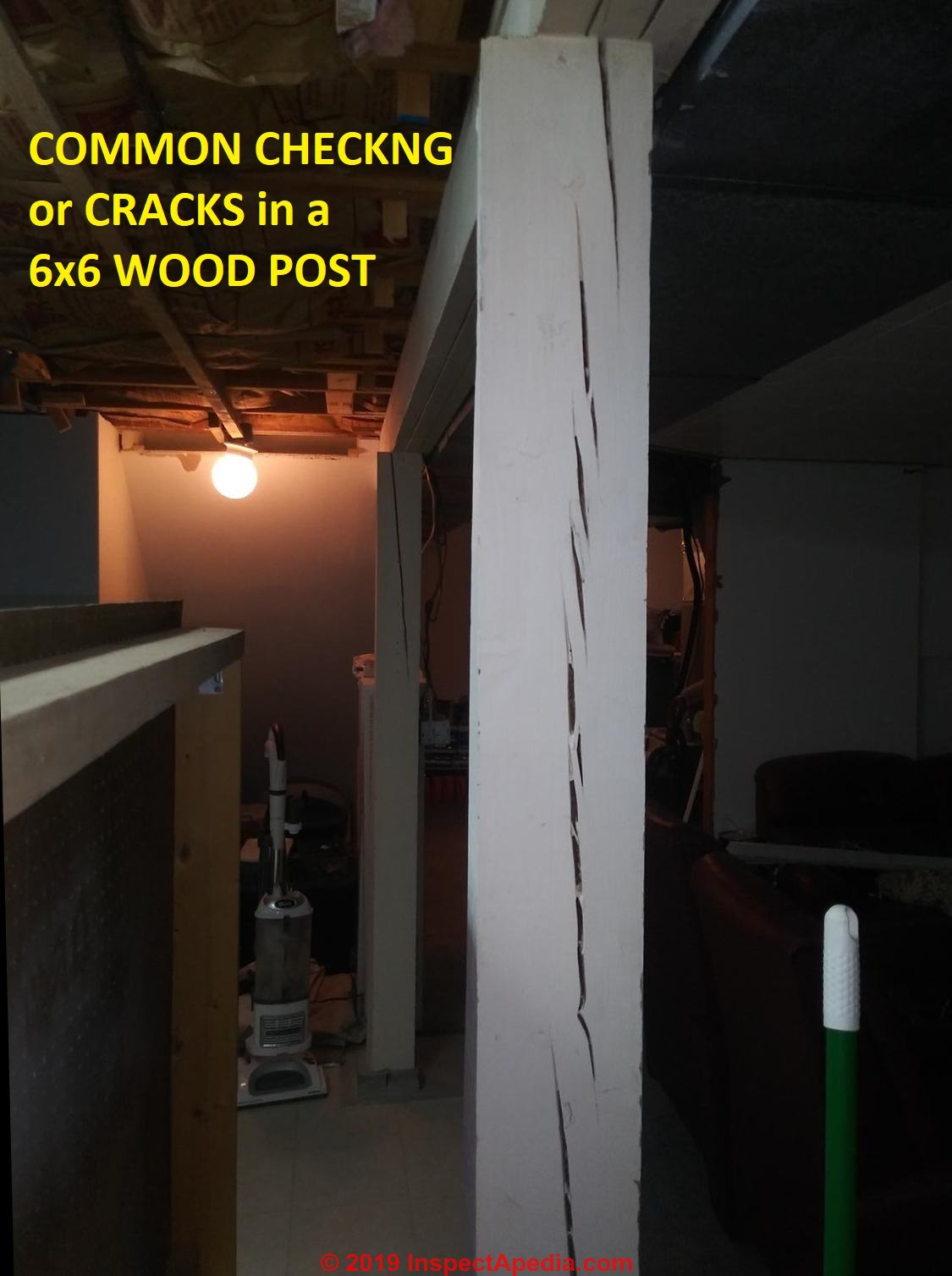 While taking out walls in the basememt my husband and I noticed these splits and that all supporting posts of the main beam do not line up with all three boards making up the suppprt beam.
While taking out walls in the basememt my husband and I noticed these splits and that all supporting posts of the main beam do not line up with all three boards making up the suppprt beam.
I would like to replace the exposed 3 support posts with new wood or metal polls but my husband says these are fine because he believes this is how the house was constructed in 1959. Any insight would be greatly appreciated.
On 2019-08-22 by (mod) - normal splits or checking cracks in a 6x6 post
Kylie
That looks like normal and harmless checking cracks in a vertical post.
On 2019-08-10 by Norbert.vandenbergh@gmail.com - Splits in post holding up treehouse
Hi! I made a 140x140 platform for a small treehouse resting on 3 round posts of 8 inch diameter and a sturdy branch. One of the posts has developed cracks about 0.4inches wide and 8 deep along its entire length (100 inch).
The cracks run almost in a right angle with the 8 x 0.8 carriage bolts connecting the posts to the 7x3.5 joists. Does it make sense to apply iron bands or replace the carriage bolts by through bolts? Any suggestions are greatly appreciated! Thanks, Norbert.
On 2019-08-10 by (mod) - extra caution about connections through a checked beam end at a high treehouse
Thanks for the photo and question Norbert.
Normally checking in a post or beam is not a structural worry.
However as your treehouse is lag-bolted through a joist into just a portion of the post, AND IF the checking is so deep that it extends more than half way through the post (which is doubtful) THEN you'd reduce the risk of a poor (and critical (single bolt !) connection by using a through bolt as you suggest.That's what I'd do, plus some nice big washers.
On 2019-08-01 by TB - cracked beam in carport roof support
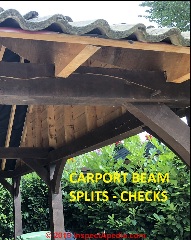 I have an oak framed carport that is developing some large cracks at the corner with a little roof sag too. Should I be worried that the roof covering is too heavy. It’s been up and in use for nearly 3 years
I have an oak framed carport that is developing some large cracks at the corner with a little roof sag too. Should I be worried that the roof covering is too heavy. It’s been up and in use for nearly 3 years
On 2019-08-01 by (mod) - Repairs probablhy needed: evaluate splits or cracks in main carport roof support beams
Let's look at some more photos to form a more confident opinion about your carport roof beams.
That's a pretty long checking crack underneath what looks like a roof with concrete tiles which can be rather heavy. So it's worth being careful about this.
I think in your photo I see checking cracks in the roof beam that is at right angles to the one you featured.
And I think that beam may not be under the same weight load.
So let's see some photos of the other beams and their cracks and also some more photos to show us which of those are carrying the roof load.
If we see the same crack patterns in both loaded and not loaded beams that would be diagnostic and would suggest that loading (from those heavy concrete roof tiles) is not the cause.
On 2019-07-17 by haithem
hi i ve got several cracks on main sporting beams while opening the walls to make some reno and was wondering if i need to do anything with that
On 2019-07-17 by (mod) - cracked main support beam?
That looks like normal checking as discussed in this article series.
On 2019-06-30 by Hsprentice@msn.com
I have checking in my 8x8 wood beams on my pole barn (I understand not a structual issue).
Upon installation they were stained with a Cabot stain and then checking occured.
Should these checks be left alone, sprayed with stain or something to protect from bugs or humidity? Looking for proper preventive maintenence and avoid doing something that could be detrimental in long run.
Thanks in advance for your input!
Thanks you
On 2019-07-02 by (mod) - rot risk on log home exteriors with upwards-facing checking splits or cracks
With the warning that there's almost certainly going to be a point of Interest or two and maybe even concerns that I cannot see by text on a building I know nothing about, checking may be an issue in your structure if the cracks face upward and are in a location where they collect
- water thus increasing the rate of rot or insect attack I'm not sure filling is necessary, but I might fill upward-facing cracks with a suitable log home sealant. But that's only on the exterior.
On 2019-06-17 by AG - home inspector said to have this post replaced
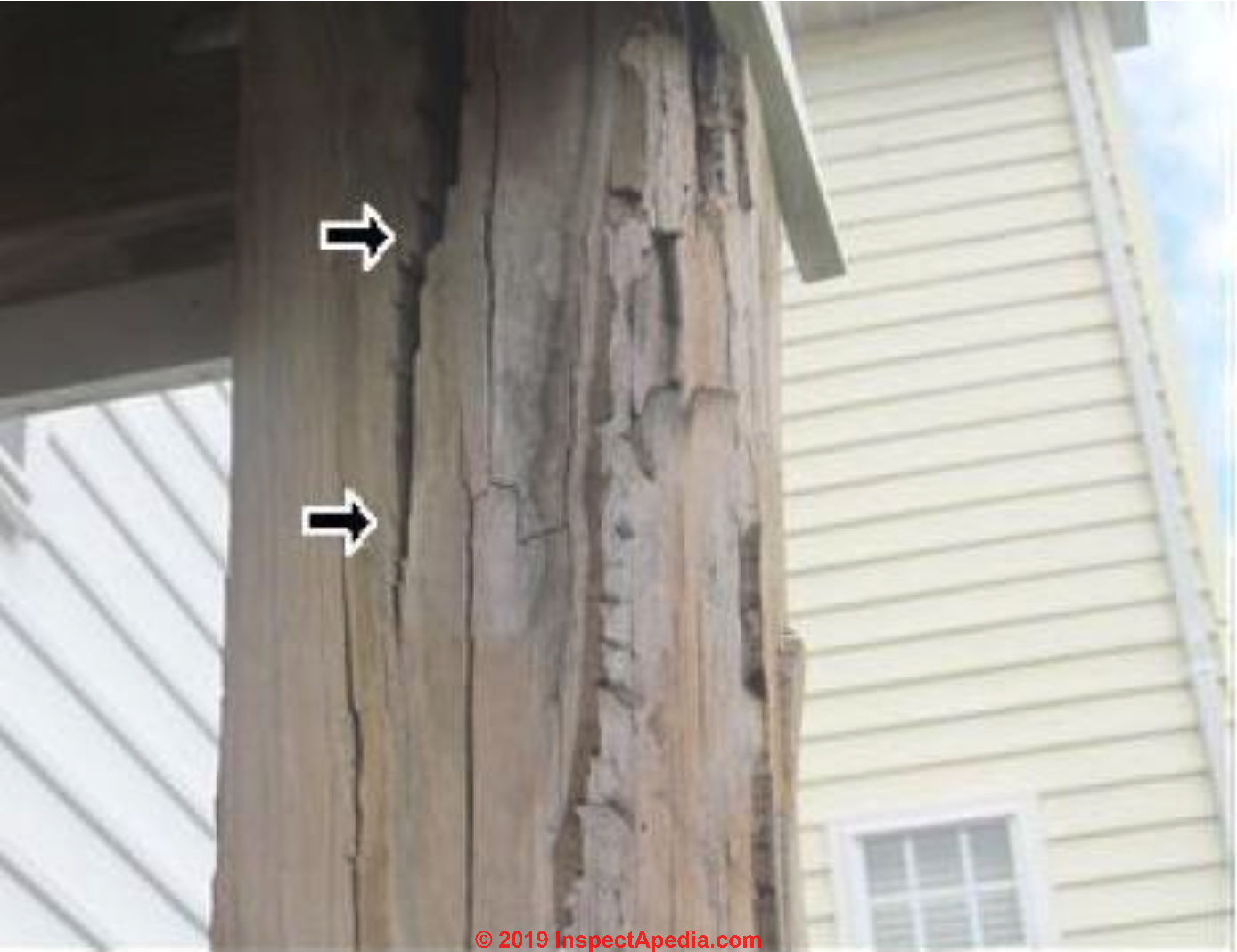 Hi, the home inspector asked this post to be replaced!
Hi, the home inspector asked this post to be replaced!
Not sure if it just checking or actual damage to the post.
Other posts have vertical cracks which seem standard checking but this one at the top seems different?
Any help will be appreciated.
thanks,
AG
On 2019-06-17 by (mod) - distinguish between checking (ok, normal splits) and actual rot in a wood post
AG
Normally vertical splits or checking in a vertical post [shown above] are not a structural concern.Watch out: But this post looks different
- it looks as if as if there may be actual rot at the post to, particularly at the outside corner and outside face of the post.
You should investigate further for signs of leaks above this point and to probe the post top to confirm that it's actually rotted
- I suspect the inspector had a good idea. Let us know what you find.
On 2019-03-26 by Second floor sag/underlying exposed beam cracks..
Hey there, I was told by a structural engineer that these are concerning. Our house is from 1920's, although I have no idea when these were added underneath the joists above for additional support. The floor is sagging, about 1 and 1/4", seven feet from the wall above. Should the beams be replaced?
Also, the joists holding up the first floor of the house, I have access to these joists as they are in the basement and there are several cracks that could use some sister joists. I was curious if leveling a fair amount of the first floor would help support the second floor support/sag in anyway?
On 2019-03-28 by (mod) - evaluate sagging beams - caused by under-sizing or overloading, not checking
Second
Here in Mexico, responding to your question, and with no information about your building or how it was constructed, I can't be smarter than your onsite structural engineer.
In general, if floors are noticeably sagging it's reasonable to opine that the structure - that is the beam size itself - may be inadequate, such as having been over-spanned or under-supported or built with too-small framing members for the spans and dimensions and weights involved.
However, I can say with some confidence that the two roughly-horizontal splits I see in the beam in the foreground of your photo look like typical wood beam checking splits that are not, themselves, a structural failure.
On 2019-03-13 by Jesse
I noticed this in my basement. The house was built in 2005. Is this a major issue or nothing to worry about?
On 2018-12-10 by Anonymous
No deflection or sagging anywhere - just this split (checking)
As the beam is outside, would you recommend sealing the split with epoxy? Or just stain it?
On 2018-12-10 by (mod) - splits or checks in wood post may be OK
That looks like a fairly common checking or split pattern to me. The only time that would be a concern would be if I actually saw it deflection or sagging in a horizontal beam or bending in a vertical wood post.
I think that's unlikely for what we can see in your photo. Take a closer look and let me know what you find.
On 2018-12-10 by Jeff
Attached photo is a solid wood vertical beam, 12" x 12" x 9' that supports a small roof overhang at front door. Construction is 3 yr old. Colorado mountains, low humidity, seasonal temp variations from -30F to 100F. Beam is exposed all day to direct sunlight. The right vertical support beam has a split from base to top, approx 1-2" wide and 4-5" deep.
Split continues the split there at construction (you can see orig stain in the first 1-2" of the crack depth. We heard the split occur a few nights ago when outside temp was -12F. The rest of the roof support structure seems unaffected - there is some much more minor checking on the back horiz support beam
Is this likely to be normal checking or something more serious?
Should I seal the newly exposed split with epoxy or just stain?
On 2018-11-27 by (mod) -
RE-posting from conversation by private email:
Reader Anonymous asked:
Concerned about the size of the crack in the main support post in our basement
Reply:
OPINION: Your post is under vertical load - compression; there is in essence no bending force being applied. The splits would normally make not one bit of concern.
However in my OPINION I'd consider a single (and quite uncommon) exception to the no-worries view.
IF you see that the sides of the post are actually buckling outwards such that the post is actually bending or bulging under load from above then you'd want to band the post to prevent further movement.
I doubt that this is happening - the load to create such a failure would have to be more than one would expect in a normal one family home.
Check for downwards deflection of the beam that this post supports. You an get a rough guess at that bending of the beam by measuring its height above the floor - presuming that your floor is level and flat.
On 2018-10-05 by (mod) - huge crack in our beam
Perhaps you could attach a photo to a comment. You will read an article above that even large checking cracks and beams are not considered a structural concern.
So a lot depends on the type and location of crack as well as of course the other conditions of the wooden beam.
On 2018-10-05 by Kristi
I have a huge crack in our beam. We bought this log cabin 2 years ago and its gotten worse. It was built in 77.
On 2017-07-16 by (mod) - fixing checking in logs or beams
Julie,
If you are asking about fixing checking in logs or beams, there is, in nearly all circumstances, no structural or functional need to "fix" those sorts of cracks.
Please take a look at our discussion of this sort of cracking in CRACKS CHECKS SPLITS in BEAMS, LOGS & POSTS.
If you are asking about a "cosmetic repair" to make the cracks disappear, that would be an unusual decision but technically possible by a combination of filling cracks with soft, non-hardening filler and staining the fill and log to match.
The cracks won't totally disappear but they can become much less noticeable. However, I don't recommend filling checking or shrinkage gaps in wood logs or beams at all.
On 2017-07-16 by Julie Elias
Can someone could fix it ?
...
Continue reading at CRACKS & CHECKS IN BEAMS, POSTS & LOGS - topic home, or select a topic from the closely related articles below, or see the complete ARTICLE INDEX.
See also CRACKS CHECKS SPLITS in BEAMS, LOGS, VIGAS & POSTS FAQs - more questions & answers about beam and log checking and cracks
Or see these
Recommended Articles
- CRACKS CHECKS SPLITS in BEAMS, LOGS & POSTS - home
- DECK COLLAPSE Case Study
- DECK POST CONSTRUCTION
- FRAMING DAMAGE, INSPECTION, REPAIR - home - for advice on looking for damaged, unsafe wood structure framing
- LOG HOME GUIDE
- ROT, TIMBER FRAME for a discussion of the cause and prevention of log checking during log or timber dry out, and for a case study of rot in timber frame construction.
- ROT, TIMBER ASSESSMENT
- ROT TYPES, BROWN SOFT WHITE
- SHRINKAGE & HEIGHT CHANGES, LOG WALL
- WOOD BEAM LOG VIGA CRACK REPAIR METHODS
- WOOD STRUCTURE ASSESSMENT - home
Suggested citation for this web page
CRACKS CHECKS SPLITS in BEAMS, LOGS, VIGAS & POSTS FAQs-3 at InspectApedia.com - online encyclopedia of building & environmental inspection, testing, diagnosis, repair, & problem prevention advice.
Or see this
INDEX to RELATED ARTICLES: ARTICLE INDEX to BUILDING STRUCTURES
Or use the SEARCH BOX found below to Ask a Question or Search InspectApedia
Ask a Question or Search InspectApedia
Questions & answers or comments about splits or cracks in wood beams or in log home log walls.
Try the search box just below, or if you prefer, post a question or comment in the Comments box below and we will respond promptly.
Search the InspectApedia website
Note: appearance of your Comment below may be delayed: if your comment contains an image, photograph, web link, or text that looks to the software as if it might be a web link, your posting will appear after it has been approved by a moderator. Apologies for the delay.
Only one image can be added per comment but you can post as many comments, and therefore images, as you like.
You will not receive a notification when a response to your question has been posted.
Please bookmark this page to make it easy for you to check back for our response.
IF above you see "Comment Form is loading comments..." then COMMENT BOX - countable.ca / bawkbox.com IS NOT WORKING.
In any case you are welcome to send an email directly to us at InspectApedia.com at editor@inspectApedia.com
We'll reply to you directly. Please help us help you by noting, in your email, the URL of the InspectApedia page where you wanted to comment.
Citations & References
In addition to any citations in the article above, a full list is available on request.
- In addition to citations & references found in this article, see the research citations given at the end of the related articles found at our suggested
CONTINUE READING or RECOMMENDED ARTICLES.
- Carson, Dunlop & Associates Ltd., 120 Carlton Street Suite 407, Toronto ON M5A 4K2. Tel: (416) 964-9415 1-800-268-7070 Email: info@carsondunlop.com. Alan Carson is a past president of ASHI, the American Society of Home Inspectors.
Thanks to Alan Carson and Bob Dunlop, for permission for InspectAPedia to use text excerpts from The HOME REFERENCE BOOK - the Encyclopedia of Homes and to use illustrations from The ILLUSTRATED HOME .
Carson Dunlop Associates provides extensive home inspection education and report writing material. In gratitude we provide links to tsome Carson Dunlop Associates products and services.


